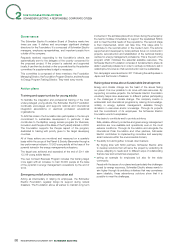APC 2011 Annual Report Download - page 92
Download and view the complete annual report
Please find page 92 of the 2011 APC annual report below. You can navigate through the pages in the report by either clicking on the pages listed below, or by using the keyword search tool below to find specific information within the annual report.
REGISTRATION DOCUMENT 2011 SCHNEIDER ELECTRIC90
SUSTAINABLE DEVELOPMENT
2METHODOLOGY ANDAUDIT OFINDICATORS
>
6. Methodology andaudit
ofindicators
6.1 Methodology elements on the published indicators
In the absence of any recognised and meaningful benchmark for
companies involved in manufacturing and assembling electronic
components, Schneider Electric has drawn up a frame of reference
with reporting methods for the Planet & Society Barometer’s
indicators and for Human Resources, safety and environment data.
This referential includes the boundaries, the collection and
consolidation procedures and the defi nitions of this information.
As it is engaged in a process of constant improvement, Schneider
Electric is gradually supplementing this work to adapt its referential
of sustainable development indicators to changes in the Group.
This document is regularly updated and additional information can
be consulted on www.barometer.schneider-electric.com.
In keeping with its commitment to continuous improvement,
Schneider Electric asked Ernst & Young to conduct a review in
order to obtain a moderate level of assurance for certain human
resources, safety and environment indicators. The audit work is
entered along with that conducted since 2006 and was broadened
to a larger number of key performance indicators from the Planet &
Society Barometer (See Auditor’s report page96 ).
Human Resources, safety and environment
indicators
The Human Resources and safety data comes from several
dedicated reporting tools, available on the Group’s Intranet,
including the One reporting tool for the Human Resources and
safety data. Its consolidation is placed respectively under the Global
Human Resources Division and the Group’s Global Supply Chain
Management. Data reliability checks are conducted at the time of
consolidation (review of variations, inter-sites comparison).
Breakdown of workforce data (by gender, category, age, and
seniority), sites declaring employee representation, the number of
collective agreements and training programs cover 80% of the total
workforce. Performance or career interviews have taken place with
more than 84% of the workforce.
This data is consolidated over all fully integrated companies within
the scope of fi nancial consolidation, when the Group has more than
a 50% stake in the subsidiary.
Units that belong to Group companies which are fully consolidated
are included on a 100% basis in reporting. Units belonging to
proportionally consolidated companies are also fully integrated.
Companies accounted for by the equity method are not included
in the reporting.
All the ISO14001 certifi ed entities must report their environmental
data. All production and supply chain sites with 50 or more
employees must obtain ISO 14001 certifi cation before the end
of the third full calendar year of operation or membership in the
Group. Administrative, R&D and sales sites with 300employees or
more had to progressively obtain ISO14001 certifi cation between
2009 and the end of 2011. Other sites may seek certifi cation and/
or report on a voluntary basis.
Indicators from the Planet & Society
barometer
The following Human Resources, safety and environment data is
used by indicators from the Planet & Society Barometer and verifi ed
by Ernst & Young: total workforce, workforce present on the ISO
14001 certifi ed sites, ISO 14001 certifi ed sites, and the accident
frequency rate.
Other data is used and consolidated under departments directly
concerned by the indicators (Human Resources, environment, the
Foundation, etc.) and each represented by a driver.
The global performance of the Planet & Society Barometer is
calculated by the Group’s Sustainable Development Department.
The indicators from the Planet & Society Barometer have a Group
scope with specifi c levels of coverage per indicator.
30,000T annual reduction of our C02 equivalent
emissions
This indicator includes:
•direct greenhouse gas emissions, i.e. emissions of SF6 in the
industrial sites concerned;
•direct and indirect emissions associated with energy use of
industrial and logistics sites and largest tertiary sites (electricity,
gas, fuel, diesel, urban heating);
•indirect emissions, related to long distance freight.
The emissions associated with these activities are converted into
CO2:
•23,900kg of CO2 per 1kg of SF6 (source: International Energy
Agency - IEA);
•Energy/CO2 ratios of the IEA. Figures are taken for the One
business program period from 2009 to 2011. These conversion
factors can be global (gas, fuel, diesel) or national (electricity,
urban heating).
























